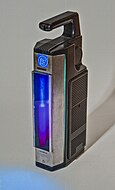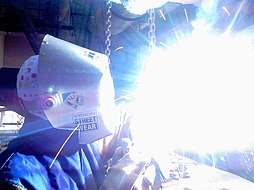Ultraviolet (UV) light is a type of electromagnetic radiation with wavelengths ranging from 10 to 400 nanometers, shorter than visible light but longer than X-rays[1]. It constitutes about 10% of the total electromagnetic radiation output from the Sun and is also produced by various artificial sources[1].
Key characteristics of UV radiation:
- Wavelength range: 10-400 nanometers
- Higher energy than visible light (3.1 to 12 electron volts)
- Can induce chemical reactions and cause fluorescence
- Mostly invisible to humans
- Has both beneficial and harmful effects on life
UV Subtypes:
| Name | Abbreviation | Wavelength (nm) | Notes |
|---|---|---|---|
| Ultraviolet A | UV-A | 315-400 | Long-wave UV, not absorbed by ozone layer |
| Ultraviolet B | UV-B | 280-315 | Medium-wave UV, mostly absorbed by ozone layer |
| Ultraviolet C | UV-C | 100-280 | Short-wave UV, completely absorbed by ozone layer |
| Near ultraviolet | N-UV | 300-400 | Visible to some animals |
| Far ultraviolet | F-UV | 122-200 | Ionizing radiation at shorter wavelengths |
| Extreme ultraviolet | E-UV | 10-121 | Entirely ionizing radiation |
History and Discovery:
UV radiation was discovered in 1801 by German physicist Johann Wilhelm Ritter[1]. Initially called “de-oxidizing rays” or “chemical rays,” the term “ultraviolet” was eventually adopted. Key milestones include:
- 1878: Discovery of UV’s sterilizing effect on bacteria
- 1903: Identification of most effective wavelengths around 250 nm
- 1960: Establishment of UV radiation’s effect on DNA
Solar Ultraviolet:
The Sun emits UV radiation at all wavelengths, including extreme UV[1]. At the top of Earth’s atmosphere, sunlight consists of:
- 50% infrared light
- 40% visible light
- 10% ultraviolet light
The atmosphere blocks about 77% of the Sun’s UV, with absorption increasing at shorter wavelengths[1].
Artificial Sources:
- Black lights: Emit long-wave UV-A radiation, used for observing fluorescence[1].
- Short-wave UV lamps: Used for disinfection in laboratories and water treatment[1].
- Gas-discharge lamps: Produce UV at specific spectral lines for scientific purposes[1].
- Ultraviolet LEDs: Increasingly common, especially in 395 nm and 365 nm wavelengths[1].
Applications:
- Sterilization and disinfection
- Photolithography in semiconductor manufacturing
- Curing of inks and resins
- Forensic analysis
- Vitamin D synthesis in humans
- Plant growth regulation
UV Protection:
Various materials and methods are used to block or absorb UV radiation:
- Sunscreens: Contain organic chemical absorbers or inorganic blockers
- Clothing: Rated by Ultraviolet Protection Factor (UPF)
- Glass: Common soda-lime glass blocks most UV below 300 nm
- Specialized materials: Wood’s glass, fused quartz, and certain crystals for specific UV applications
Detection and Measurement:
UV can be detected and measured using:
- Photodiodes and photocathodes
- Photomultipliers
- Spectrometers and radiometers
- Silicon detectors (across the spectrum)
Effects on Life:
UV radiation has both positive and negative impacts on living organisms:
- Beneficial: Vitamin D synthesis, regulation of plant growth
- Harmful: Sunburn, increased risk of skin cancer, DNA damage
In conclusion, ultraviolet radiation plays a significant role in various natural phenomena and has numerous applications in science, technology, and medicine. Its study and utilization continue to be important in fields ranging from astrophysics to dermatology[1].
[glossary_wikipedia]
Ultraviolet (UV) light is electromagnetic radiation of wavelengths of 10–400 nanometers, shorter than that of visible light, but longer than X-rays. UV radiation is present in sunlight, and constitutes about 10% of the total electromagnetic radiation output from the Sun. It is also produced by electric arcs, Cherenkov radiation, and specialized lights, such as mercury-vapor lamps, tanning lamps, and black lights.
The photons of ultraviolet have greater energy than those of visible light, from about 3.1 to 12 electron volts, around the minimum energy required to ionize atoms. Although long-wavelength ultraviolet is not considered an ionizing radiation because its photons lack sufficient energy, it can induce chemical reactions and cause many substances to glow or fluoresce. Many practical applications, including chemical and biological effects, are derived from the way that UV radiation can interact with organic molecules. These interactions can involve absorption or adjusting energy states in molecules, but do not necessarily involve heating. [citation needed] Short-wave ultraviolet light is ionizing radiation. Consequently, short-wave UV damages DNA and sterilizes surfaces with which it comes into contact.
For humans, suntan and sunburn are familiar effects of exposure of the skin to UV light, along with an increased risk of skin cancer. The amount of UV light produced by the Sun means that the Earth would not be able to sustain life on dry land if most of that light were not filtered out by the atmosphere. More energetic, shorter-wavelength "extreme" UV below 121 nm ionizes air so strongly that it is absorbed before it reaches the ground. However, ultraviolet light (specifically, UVB) is also responsible for the formation of vitamin D in most land vertebrates, including humans. The UV spectrum, thus, has effects both beneficial and detrimental to life.
The lower wavelength limit of the visible spectrum is conventionally taken as 400 nm, so ultraviolet rays are not visible to humans, although people can sometimes perceive light at shorter wavelengths than this. Insects, birds, and some mammals can see near-UV (NUV), i.e., slightly shorter wavelengths than what humans can see.

